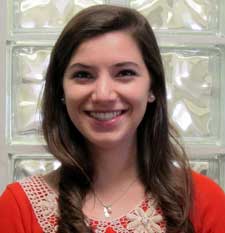AUGUST 27, 2014
A closer look at the brain and undergraduate research at the UofA
 Autri Hafezi (r), 2012 Cactus Shadows High School graduate and University of Arizona (UA) neurosciences major, spent the summer as a research assistant in the Visual Cognition Laboratory under the guidance of Dr. Paige Scalf. Facilitated by the UA Undergraduate Biology Research Program (UBRP), Autri learned first-hand about brain imaging and visual neuroscience research. She specifically investigated how perceptual learning alters neural interactions in visual cortex.
Autri Hafezi (r), 2012 Cactus Shadows High School graduate and University of Arizona (UA) neurosciences major, spent the summer as a research assistant in the Visual Cognition Laboratory under the guidance of Dr. Paige Scalf. Facilitated by the UA Undergraduate Biology Research Program (UBRP), Autri learned first-hand about brain imaging and visual neuroscience research. She specifically investigated how perceptual learning alters neural interactions in visual cortex.
Although the information in the visual world is nearly infinite, our capacity to represent that information is limited. When multiple visual items are simultaneously present, they must compete for these limited representational resources. This competition occurs through a series of mutually suppressive interactions among neurons that results in a less clear percept of the objects than that formed when the objects are presented one at a time. Often, however, multiple objects may form a single visual item; for example, a group of tokens, cards and a board may be identified as a board game. Scalf and Autri are investigating whether multiple visual objects continue to compete for representation (that is, continue to suppress one another) if participants have been trained to recognize that group of items as a single item.
Such a finding would be important for two reasons. First, it would demonstrate that the interactions among neurons that represent multiple visual objects change as a function of the relationship among those objects. Second, it would demonstrate one way in which perceptual training might improve both the quantity and quality of visual information that we can represent.
Over the course of a few days, we will train study participants to recognize groups of visual objects. We will then use functional magnetic resonance imaging (fMRI) to assess processing in visual cortex. We will examine fMRI signal to determine whether there is less suppressed neural activity when participants view groups of objects they have been trained to recognize rather than groups of objects with which they are unfamiliar. Data is collected at the Medical Research Facility at the UA Medical Center.
What does a standard day in an imaging laboratory look like? The days start out with scheduling participants for studies. Whether by email, telephone, or fliers around campus, the word gets out! If someone is available and interested, s/he is screened for compatibility and safety. When s/he arrives at the laboratory, the behavioral task being presented is further explained, and then the fun begins! Participants are trained to name 10 groups of five objects. The highlight of each week is venturing to the scanner. It is here that high resolution brain images are acquired for analysis.
At UA, research is underway to learn more about the neural underpinning of visual processings, attention, and learning. Through UBRP, undergraduate students are engaged in critical thinking skills, given opportunities for mentored, university-level research, and provided a supportive community of like-minded students. Be sure to support this next generation of scientists as they embark on important undertakings!



